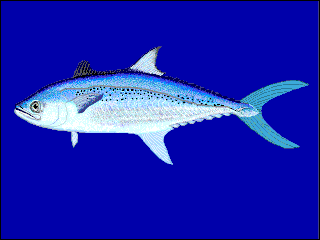
The streaked Spanish mackerel is found mainly in and around India, especially along the Maharashtra and Gujarat coasts. The peak season for fishing this fish is from October to December. It is also known by other names, such as streaked seer, hazard (French), sawara, and carite (Spanish). It is found off Asian coasts from the west coast of India and Sri Lanka east to Java and does not extend east of Wallace's Line. It is an important quarry species for fisheries where it occurs.

The bristly catshark is a cat shark of the family Scyliorhinidae, found from southeastern India and the Andaman Islands, between latitudes 15° N and 5° N, at depths between 200 and 300 m. Its length usually ranges from around 20–26 cm, and it is regarded as the smallest catshark of Bythaelurus.

The green chromide is a species of cichlid fish that is native to fresh and brackish water habitats in some parts in India such as Kerala, Goa, Chilika Lake in Odisha and Sri Lanka. The species was first described by Marcus Elieser Bloch in 1790. Other common names include pearlspot cichlid, banded pearlspot, and striped chromide. In Kerala, it is known locally as the karimeen (കരിമീൻ).In Tamilnadu,it is known locally as the 'pappan or pappa(பப்பான்,பப்ப)' In Goa the fish is known as kalundar. In Odisha, the local name is kundal(କୁଣ୍ଡଳ ମାଛ). In Sri Lanka this fish is known as koraliya (කොරළියා).

Cavefish or cave fish is a generic term for fresh and brackish water fish adapted to life in caves and other underground habitats. Related terms are subterranean fish, troglomorphic fish, troglobitic fish, stygobitic fish, phreatic fish and hypogean fish.

Hypselobarbus is a genus of fish in the family Cyprinidae endemic to India.

The Curmuca barb is a species of ray-finned fish in the genus Hypselobarbus which is endemic to upland streams and rivers in southern India.

The Nilgiris barb, also called the cock fish, is a tropical species of freshwater cyprinid fish. It is native to India. It is potamodromous, benthopelagic, and less than 25 cm long.

Hypselobarbus jerdoni, also known as Jerdon's carp, is a species of cyprinid fish endemic to India where it is found in larger streams of southern Karnataka, Tamil Nadu, Kerala and Maharashtra. This species can grow to a length of 46 centimetres (18 in) TL. It is caught commercially for human consumption.
Hypselobarbus kolus is a species of ray-finned fish in the genus Hypselobarbus which is endemic to the Western Ghats in southern India in the states of Kerala, Karnataka, Tamil Nadu and Maharashtra. It has been recorded from the rivers Chalakudy, Periyar, Muvattupuzha and Karamana, Linganamakki Dam on the Sharavathi River, Krishna River, Thamirabarani, Bhima River, Godavari and Bhadra.
Hypselobarbus kurali is a species of ray-finned fish in the genus Hypselobarbus which is endemic to the southern Western Ghats.

Hypselobarbus lithopidos is a species of ray-finned fish in the genus Hypselobarbus. It is possibly extinct as it has not been recorded since the 1940s and its true taxonomic status needs to be ascertained.

Hypselobarbus micropogon, the Korhi barb, is a species of cyprinid fish from India where it is it is restricted to the headwaters of Kaveri.
Hypselobarbus periyarensis is a species of cyprinid fish endemic to Periyar Lake in Kerala, India. This species can reach 50 cm (20 in) in total length.

Hypselobarbus pulchellus is a critically endangered species of ray-finned fish in the genus Hypselobarbus. It is currently only recorded in the Dakshina Kannada district of Karnataka, India.

Hypselobarbus thomassi is a critically endangered species of ray-finned fish in the genus Hypselobarbus. It is endemic to the Western Ghats in Karnataka and Kerala, India. This species is potentially a very large fish, growing to 100 cm (39 in) TL, possibly even larger.

The Korean mackerel also known as the Korean seerfish, is a ray-finned bony fish in the family Scombridae, better known as the mackerel family. More specifically, this fish is a member of the tribe Scomberomorini, the Spanish mackerels. It has an Indo-Pacific distribution which extends from the east coast of India and Sri Lanka along the Asian continental shelf to Sumatra then north to Korea and Wakasa Bay in the Sea of Japan. This species is of minor commercial importance in some parts of its range where it is taken using gill nets and is marketed either fresh or dried-salted. The Korean mackerel is an important quarry species for the drift net fishery in Palk Bay and the Gulf of Mannar in India.
Oryzias carnaticus or the spotted ricefish are a freshwater–brackish fish species native to the India, Bangladesh, Sri Lanka, and Myanmar. Their maximum length is only 3.0 centimetres (1.2 in). They are normally found near the coast, and can live in fresh water and brackish water.

The humpback mahseer is a species of freshwater ray-finned fish from the Indian endemic genus Hypselobarbus in the carp and minnow family Cyprinidae.
Hypselobarbus pseudomussullah is a species of cyprinid in the genus Hypselobarbus. It inhabits Karnataka and Maharashtra, India, and has a maximum length of 24.1 centimetres (9.5 in).














